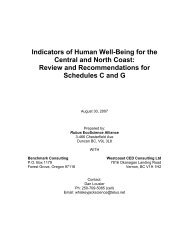Final report - Integrated Land Management Bureau
Final report - Integrated Land Management Bureau
Final report - Integrated Land Management Bureau
You also want an ePaper? Increase the reach of your titles
YUMPU automatically turns print PDFs into web optimized ePapers that Google loves.
2.1.3 Economy<br />
Transportation Assessment of the Central & North Coast of BC<br />
The economy of the transportation study area has historically depended on<br />
resources, although this pattern has changed during the past decade with the<br />
growth and diversification of the service sector, and decline in the coastal forest<br />
industry. Between 2001 and 2006, the total number of jobs in the study area<br />
declined from approximately 15,880 to 13,430, an outflow of about 2,450<br />
workers. 11<br />
Overall, the public sector − which includes school district, hospital and First<br />
Nations, local, provincial, and federal government staff − accounted for<br />
approximately 3,655 jobs, or 27% of employment in the transportation study area<br />
in 2006. 12 The mining sector was in second place, generating 1,500 jobs (11% of<br />
total), due largely to the inclusion of Kitimat in these estimates. Retail was the<br />
third-largest sector, accounting for 1,300 jobs, or 9.8% of all employment in the<br />
study area. Accommodation and food, and the transportation sector, each<br />
accounted for 1,000 jobs or 7.5% of the labour force. And the logging & forest<br />
products industry made up 885 jobs, or 6.6%.<br />
The importance of the forest industry has declined. Census data shows that<br />
logging accounted for 11% of all employment in 2001, declining to 6.6% in 2006.<br />
The fishing industry is historically a major player in the Central and North Coast<br />
economy, and although reduced in importance in recent years through smaller<br />
salmon returns and license restructuring, it remains a significant force, accounting<br />
for employment of approximately 1,135 in the transportation study area.<br />
Mining continues to be a dominant employer in the transportation study area, due<br />
to Alcan’s smelting operations in Kitimat. The number of workers employed in this<br />
industry in 2006 (1,500) was approximately the same as in 2001. The prospects for<br />
mining are good, with major new projects now in the planning phase, and this<br />
sector is likely to grow in the years to come. 13<br />
While the overall labour market shrank in the transportation study area between<br />
2001 and 2006, the sector share of some industries grew during this time. One<br />
example of this is the public sector on the Central Coast which grew from 40% of<br />
all jobs in 2001 to 45% in 2006. On the North Coast, the number of jobs in<br />
wholesale trade, and transportation and warehousing, an outcome of Port of Prince<br />
11<br />
BC Statistics. Community Facts. Labour Force by Industry (NAICS). Taken from Census 2001 and 2006.<br />
October 2008. The table includes results for Prince Rupert, Port Edward, Kitkatla, Hartley Bay, Metlakatla<br />
and Area A of the Skeena-Queen Charlotte Regional District, Central Coast Regional District and Kitimat.<br />
Some smaller communities are not included due to lack of data.<br />
12<br />
BC Statistics. Community Facts. Labour Force by Industry (NAICS). Taken from Census 2001 and 2006.<br />
October 2008.<br />
13<br />
Note that the economic role of the minerals sector is much smaller in the LRMP Plan areas, which do not<br />
include Kitimat.<br />
Chisholm Consulting 9

















